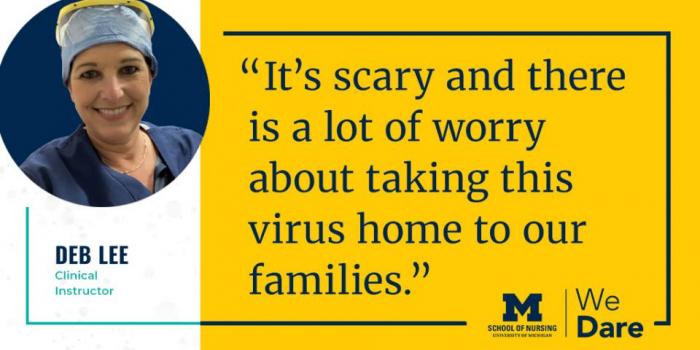Clinical Instructor Deb Lee is providing critical care to all types of patients on the front lines of the COVID-19 pandemic
As health care professionals around the world continue providing care to patients amid unprecedented circumstances, we will explore how the U-M School of Nursing faculty is deploying its breadth of knowledge and clinical experience during the COVID-19 pandemic. Many U-M School of Nursing faculty members are taking on new challenges caring for patients in communities across the state of Michigan …

Clinical Instructor Deb Lee, MSN, FNP, ACNP-BC, is working long hours caring for COVID-19 patients in the ICU at Borgess Medical Center in Kalamazoo, Michigan, navigating new approaches at the hospital and adjusting to a different way of life at home.
Lee is currently working five days in the hospital’s COVID-19 intensive care unit and two days assisting with palliative care.
In the ICU, all of Lee’s patients are on ventilators, including an increasing number of patients from local prisons – a troubling sign of how quickly the virus can spread among incarcerated populations and those who work alongside them. To date, more than 600 prisoners in Michigan have contracted COVID-19.
“The prisons are trying to comply with the social distancing, but it is very difficult for obvious reasons,” said Lee.
Incarcerated patients also require careful non-medical monitoring. As Lee explains, each patient must have two guards at their bedside. These exhausted guards are working 16-hour shifts in the ICU and sleeping in local hotels.
“There are 1,400 prisoners locally, and we are very concerned that more prisoners will need ICU care,” said Lee.
Caring for any COVID-19 patient requires intensely thorough precautions that have altered the way experienced practitioners like lee approach their work. At Borgess, they have formed a specialized intubation team as well as a proning team that helps turn patients from their backs to their stomachs every 12 hours.
“Once a patient has been intubated, the virus is believed to be airborne in the room for up to three hours, so we try to avoid going into the room for a few hours after intubation or extubation,” Lee said.
Limiting direct contact is important to protect frontline health care workers, but doing so while continuing critical care is a delicate balance that requires constant innovation and adaptation.
“Providers and nurses are trying every day to figure out how to manage these patients,” said Lee. “There is not strong evidence to support a certain type of treatment, so we try different interventions to see if they will work.”
Nurses have taken simple steps such using ice packs and cold clothes to reduce patients’ temperatures. They’ve also adopted more complex methods like re-engineering the way they administer IV fluids in the ICU.
“We have been putting extra tubing on the IV lines and putting IV pumps outside the room so we don't have to go in the room to change critical IV drips,” Lee explained.
As Ford Motor Company works to produce 50,000 ventilators over the next month, Lee has advised the company on the development of a remote control that allows providers to change ventilator settings without entering a room.
“Ford was very receptive and agreed to work on this during production,” she said.
COVID-19 care often goes beyond clinical treatment. Lee described how intense isolation can leave patients scared and confused as their distressed family members struggle with the inability to support their loved ones in person.
“I spoke to a daughter with both parents on ventilators in the ICU,” she said. “We were able to spend a lot of time on the phone explaining every detail of what was going on. This helped her calm down and feel connected to her parents, and I also made sure her mother and father knew were we were talking with their daughter every day.”
Nurses and other frontline health care workers aren’t immune to the physical and emotional tolls of the pandemic. Protecting themselves through nonstop shifts can complicate even simple tasks like staying hydrated.
“It’s very hard to work 12 hours in the ICU with a mask on at all times, but it has to be done,” Lee said. “We are finding that we can't drink much because we always have a mask on. When we want to take a drink, we go into an office, close the door, take our mask off and drink as much as we can for a few short minutes.”
Outside of the hospital, an altered version of everyday life continues, and nurses have to make difficult decisions to protect their families. Lee hasn’t seen her 18 and 20-year-old sons in weeks, and when she finally arrives home each night, she is taking extra precautions.
“We are able to talk on the phone, but it’s not the same as giving them a hug every night,” she said. “I don't even get to see my significant other until I’ve come home, put my clothes in the washer and taken a full shower. It’s scary and there is a lot of worry about taking this virus home to our families.”





